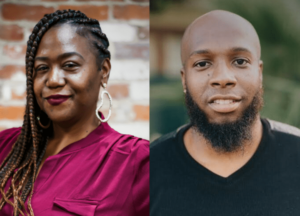Lenore Anderson’s book, In Their Names: The Untold Story of Victims’ Rights, Mass Incarceration, and the Future of Public Safety, was borne out of the need for victim-centered stories. As such, Lenore opened the talk not with her own background, but with a story of a victim: Eric.
Eric was shot and paralyzed when he was a bystander to a crime. With piling medical bills, an inability to work, and a need for new, accessible accommodation, Eric applied several times for victim compensation. Each time he applied, Eric was denied for victim compensation. His dire financial situation led him to sell the pain medication he was prescribed, and he got arrested for selling drugs. With a criminal record, finding employment and housing proved even more difficult. This story, as Anderson noted, parallels the experiences of many other victims who face barriers to accessing compensation and services.
At an April book talk co-hosted by SCRJ, the Stanford Criminal Justice Center, and the Haas Center for Public Service, Anderson spoke about her own journey, the interlocking systems of victim disregard and mass incarceration, and the hope for the future. Anderson’s first job representing incarcerated youth in California—“the birthplace of the tough on crime movement”—led her to advocate alongside parents for policy reform. At the time, she was met with resistance, but much has changed. Voter opinion has shifted toward rehabilitation. Knowledge of the “perils of mass incarceration” has increased. Despite this, she said, reform is still an uphill battle.
Speaking about victim disregard and mass incarceration, Anderson noted how these issues are two sides of the same coin—and yet victim disregard receives minimal attention, including by police departments (in California, police departments allocate about one percent of their budget to victims’ services). “One-fourth of people in the U.S. will be a victim of crime, less than half of these victims receive support,” Anderson said. She pointed out that victimhood is not uniformly experienced: the risk of being a repeated victim is concentrated in communities of color, low-income communities, and the LGBTQ community. All too often, victims are left with “no healing, no safety, no justice.” Mass incarceration compounds these issues by reinstating cycles of trauma wherein victims that did not receive support often end up being incarcerated, which exposes victims to more trauma (direct exposure or secondary expose to violence in prison or jail). These questions should lead us to collectively ask: What does safety really look like? For Anderson, it looks like trauma recovery centers, reentry programs, and grassroots community organizations. It looks like “seeing people, giving people dignity, and saying how can I help you.”

The two other panelists, Tinisch Hollins, Executive Director of Californians for Safety and Justice, and Aswad Thomas, Vice President of the Alliance for Safety and Justice (ASJ), spoke about their personal experiences with disparities in victim services. As a victim, Thomas “never accessed victim compensation, victim services, therapy, or housing relocation support” and noted how his shooter was himself a victim of gun violence and unaddressed trauma. Thomas and Hollins have both seen close friends and family receive little to no support as victims, which prevents them from resuming their normal lives, they said. Hollins also noted how there are “too many doors to receiving support,” resulting in victims being “locked out of support, their own homes, and their community.”
Speaking on solutions to trauma, Thomas and Hollins offered insight into the path forward. For Thomas, changing policy and laws, centering the stories of victims and their families, investing in trauma recovery centers, and addressing the root causes of violence are valuable strategies to combatting cycles of violence and trauma in communities of color. Moving away from a reimbursement-based model for victims’ services was a solution Hollins elevated. She explained that presently, victims need to provide proof and meet eligibility requirements before receiving reimbursement, which burdens victims by requiring them to front expenses while physically and mentally recovering. Expanding upon the value of trauma recovery centers, Thomas characterized these centers as “one stop shops for comprehensive mental help, aid with the long victim compensation process, and connection to other social services.” Hollins added that trauma recovery centers also allow victims to immediately access help by trusted community members. However, she noted that these centers are often overwhelmed by community demand, which calls for increased investment in expanding current—and building new—trauma recovery centers.

Importantly, these solutions should operate alongside a larger shift in narratives surrounding safety. Listening to survivors, training them to be storytellers, and centering their advocacy regarding what they want out of the justice system holds incredible power, Thomas explained. His work with members of ASJ has led to changing victim compensation in ten states and passing more than 50 bills that remove barriers to victim services and advocate for criminal legal reform. Hollins emphasized that survivor-led innovation solutions expand on what we mean when we say public safety. Safety looks like “survivor led trauma recovery centers [and when] people who were formerly incarcerated are the leaders against gun violence in their community.”
However, these solutions require mobilization. To win and sustain changes, people must get involved. Anderson closed the conversation by noting that the criminal legal system is “far too comfortable reverting back to the norm, which has been a norm of trauma on top of trauma.” If interested in contributing to these efforts, Anderson called for people to join herself, Thomas, and Hollins at Californians for Safety and Justice and Alliance for Safety and Justice.